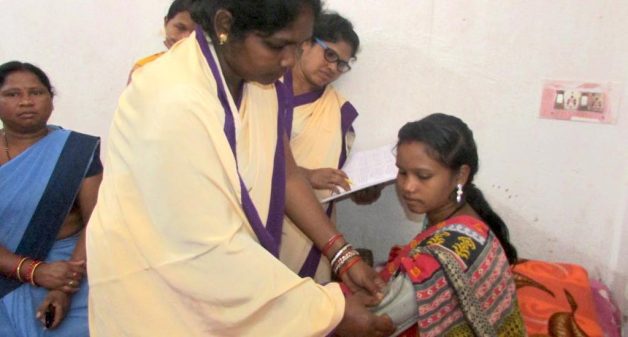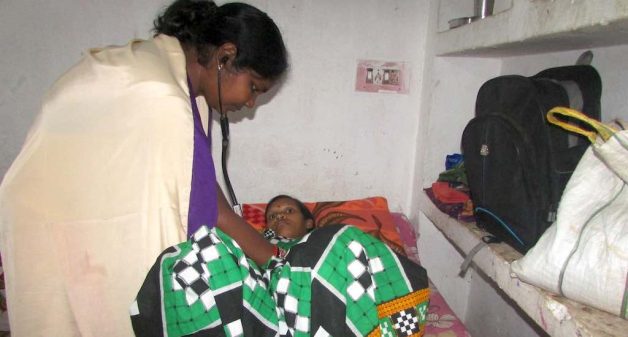
Maternity homes provide safe haven to tribal women
Pregnant women from tribal villages in Kandhamal that lack roads and mobile phone connectivity have found a safe shelter in intermediary maternity homes that prepare them for institutional delivery

Pregnant women from tribal villages in Kandhamal that lack roads and mobile phone connectivity have found a safe shelter in intermediary maternity homes that prepare them for institutional delivery
Expectant mother Sasmita Nayak (19) of Baghadangiri village in Phiringia administrative block of Kandhamal district is relieved that she will not have to be carried in a rope cot across rough mountain roads to a hospital for her confinement.
Women living in inaccessible villages in some of the districts of Odisha face enormous difficulties to reach hospitals for institutional delivery. They have to cross rough terrains, hills, and sometimes streams. Often they are carried in rope cots or slings.
Nayak is relieved because she has moved into a maternity home in Baldapada panchayat near her village. Thanks to maternity homes, better known as Maa Gruha, set up by non-government organizations with the support of National Health Mission in different districts of Odisha, pregnant women (mostly tribal and Dalit women of far-flung villages) stay during advanced stages of pregnancy for institutional delivery.
Poor access to hospitals
In Kandhamal district, villagers are aware of institutional delivery. But inaccessible areas infested with Maoist insurgents, poverty, early marriage, and very little nutritional food make them anemic, and they end up delivering low birth weight babies.
“Not just lack of access, they are engaged in both household and agriculture works. They also go into forests to collect firewood and other produce and do not bother about their health,” said Shankar Narayan Mohanty, project coordinator at Social Welfare Agency & Training Institute (SWATI), a non-governmental organization that runs a maternity home at Baldapada panchayat, told VillageSquare.in.

There are remote villages in Pahiraju, Luisingh, Baldapada, Pokari, Kuirimandu and Krandibali panchayats of Phiringia block that lack mobile phone connectivity. So, when a pregnant woman develops labor pain or is at health risk, the family cannot call the ambulance.
“Most of the time we carry them in a rope cot or a sling to a point from where an auto-rickshaw takes us to a place an ambulance can access. The ambulance takes the women to a Primary Health Centre (PHC) or a Community Health Center (CHC) for institutional delivery,” Lalita Sahu, an accredited social health activist (ASHA), told VillageSquare.in, showing mobile phone pictures of pregnant women being carried in slings.
Changing mindset
Nayak, who lives in one of these far-flung villages, was found to be anemic when she attended Village Health Nutrition Day (VHND). The ASHA who examined her suggested shifting to a maternity home. The ASHA and the health assistant of the maternity home said that they had a difficult time convincing her family to shift her to the maternity home.
Though maternity homes are a boon for pregnant women of these inaccessible villages, they are reluctant to stay there. The family members are reluctant, as their absence would mean additional work for them. “Besides, they prefer home delivery to institutional delivery. They fear that they would be forced into a C-section surgery but things are changing now,” said Lalita Sahu.
“Most of the girls in these villages marry early as child marriage is still prevalent here, and early marriage affects their reproductive health,” Pushpita Sahu, coordinator of the maternity home and a trained auxiliary nurse midwife (ANM), told VillageSquare.in. “As their wombs are not fully developed and due to lack of nutritional food intake and the burden of household and farm work make them anemic.”
“Sasmita’s case is no different. At the maternity home we did regular medical check-up, after consulting the doctor we insisted that she should take folic acid and calcium tablets on time, provided nutritional food and rest, and her health condition has now improved,” said Pushpita Sahu.
Support from health assistants
Sunita Digal (20) of Tilkapanda village was also anemic and her ASHA advised her to stay at a maternity home before her expected delivery date (EDD). “The health assistant keeps a chart of blood pressure and weight, and takes me to the nearby CHC every week for abdominal check-up. They provide nutritional food three times a day which is good for the growth of my expectant child,” Digal told VillageSquare.in.
Digal said that they take her for a walk twice daily and make her do small works, whereas it had been painful earlier since she had to work in agriculture fields for hours in bending or squatting position.
“In these far-flung villages, language barrier is another issue. If you convince them in their tribal Kui language they will easily follow,” Chanchala Kanhara, a Kondh health assistant, who counsels in Kui language, told VillageSquare.in. “We just have to convince them as everyone wants a safe delivery and a healthy baby.”

The maternity home operating in Baldapada panchayat since 2013 caters to pregnant women of six panchayats in Phiringia block. Till date 1,127 pregnant women have received care, nutrition and counseling. They now prefer to stay here till both mother and child can return home after a safe delivery. “Sometimes husbands with other young children are allowed to stay since it has a positive impact on the health of the mother,” said Pushpita Sahu.
Need to equip CHCs
After Maa Gruha concept, institutional delivery or safe delivery has increased in these parts of the district. Apart from mother care, post-delivery the women are counseled on baby care and in following nutritional food chart. In these six panchayats more than 90% tribal women have started preferring institutional delivery due to Maa Gruha.
But, there are other hurdles in the path of safe delivery. “Due to illiteracy, young women are unable to say the exact last menstruation period, so it is difficult to count the exact EDD,” said Sahu. “The CHC near the maternity home in Beldapada is not fully equipped and if they develop false pain or any complication, we rush them to the district hospital at Phulbani, which is quite far, for ultrasound.”
Besides, the medical officer of this CHC does not visit regularly. “For all this we bear the expenses and sometimes we ask families of pregnant women to bear the expenses,” said Mohanty. “There have been instances of women being carried in cots or slings dying before reaching the hospital.”
Safe delivery is the right of every pregnant woman; if road connectivity to remote villages improves it will reduce maternal deaths. The health assistants have been playing a significant role in convincing pregnant women and their families about maternity home and institutional delivery. A woman who returns to the village with her healthy baby encourages other pregnant women and their families to send them to Maa Gruha.
Rakhi Ghosh is a Bhubaneswar-based journalist. Views are personal.